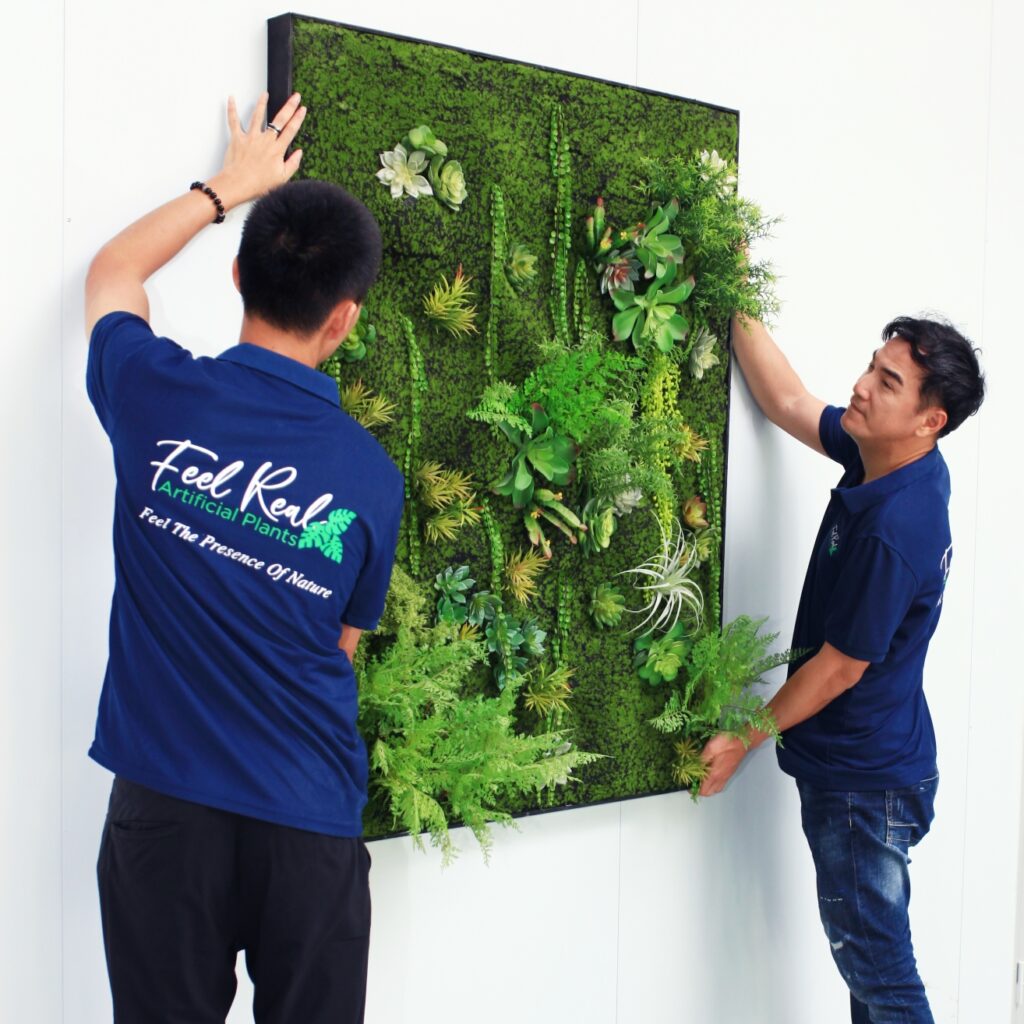With its vast and diverse landscape, the United States presents significant opportunities for manufacturers like us. In this comprehensive guide, we delve into the seasonal dynamics of artificial plant wholesaling in the US, providing valuable insights to wholesalers to enhance their understanding and optimize their strategies.

1. Market Overview:
The US market for artificial plants is not only vast but also incredibly diverse, presenting a multitude of opportunities for wholesalers. Over recent years, we have witnessed a significant shift in consumer preferences and lifestyle trends, with artificial plants emerging as favored décor solutions for a variety of spaces. From cozy homes to bustling offices and vibrant commercial establishments, the demand for artificial greenery continues to soar.
One of the key driving factors behind this surge in popularity is the growing recognition of artificial plants as cost-effective and low-maintenance alternatives to their living counterparts. As individuals lead increasingly busy lives, the appeal of having lush, lifelike greenery without the hassle of watering, pruning, or sunlight requirements cannot be overstated. This shift in mindset has led to a widespread adoption of artificial plants across various segments of society, from young urban professionals to busy families and seasoned business owners.
At our factory, we have always been at the forefront of catering to these evolving needs and preferences. Our unwavering emphasis on offering low prices without compromising on quality has earned us a reputation for reliability and affordability in the market. Moreover, our extensive range of styles ensures that there is something to suit every taste and aesthetic preference, whether it be sleek and modern or classic and traditional.
2. Understanding Seasonal Trends:
– Spring:
Spring marks the beginning of the peak season for artificial plant sales in the US. As consumers embark on spring cleaning and home improvement projects, there is a surge in demand for fresh and vibrant greenery to refresh indoor and outdoor spaces. Distributors and retailers stock up on a variety of plants, including flowering bushes, hanging baskets, and seasonal arrangements, to cater to this seasonal demand.
– Summer:
During the summer months, outdoor entertaining and gardening activities drive the demand for artificial plants that can withstand the heat and sunlight. Durable and UV-resistant plants such as artificial palms, ferns, and succulents are in high demand for landscaping, patio décor, and poolside accents. Additionally, retailers may introduce seasonal promotions and discounts to capitalize on the summer sales season.

– Fall:
As the temperatures start to cool down, consumers transition their focus to autumnal décor themes. Warm hues, rustic textures, and seasonal foliage become popular choices for artificial plant arrangements. Pumpkins, gourds, and fall leaves are incorporated into displays, wreaths, and centerpieces, catering to the demand for festive and cozy accents during the fall season.
– Winter:
The holiday season brings a flurry of activity in the artificial plant wholesale market. From Christmas trees and wreaths to garlands and poinsettias, retailers stock up on holiday-themed décor to create festive atmospheres in homes, stores, and public spaces. Our factory’s OEM service allows retailers to customize products with specific holiday themes, colors, and designs to meet the unique needs of their customers.
3. Strategies for Seasonal Optimization:
– Forecasting and Planning:
Anticipating seasonal trends and aligning production schedules accordingly is critical to maintaining optimal inventory levels and meeting customer demand effectively. At our factory, we employ a comprehensive approach to forecasting and planning that involves collaboration with designers, landscapers, and other industry experts.
Anticipating Seasonal Trends: Closely monitor market trends and consumer preferences to anticipate shifts in demand throughout the year. By analyzing historical sales data and market research reports, you can gain insights into seasonal patterns and emerging trends. This allows us to forecast demand for specific product categories and plan production schedules accordingly.
Collaboration with Designers and Landscapers: Work closely with designers, landscapers, and other industry professionals to gather insights and forecast sales projections. These experts provide valuable input on upcoming design trends, popular color schemes, and seasonal themes. By collaborating with them, you can gain a deeper understanding of customer preferences and can tailor our product offerings to meet evolving design trends.
Data Analysis and Forecasting: Leveraging advanced data analytics tools, we analyze sales trends and historical data to forecast future demand accurately. By identifying patterns and correlations in customer purchasing behavior, you can anticipate peak demand periods and adjust production schedules accordingly. This data-driven approach enables you to optimize inventory levels and minimize the risk of stockouts or excess inventory.
Seasonal Planning and Product Development: Based on our forecasting insights, we develop seasonal production plans and introduce new product lines to align with anticipated demand. For example, ahead of the spring season, you can increase the stock of floral arrangements and outdoor foliage to cater to customers’ gardening and landscaping needs. Similarly, during the holiday season, we focus on producing festive-themed decorations and artificial Christmas trees.
– Seasonal Product Offerings:
Adapting our product offerings to align with seasonal themes and consumer preferences is key to staying relevant and maximizing sales potential. At our factory, we understand the importance of catering to evolving tastes and trends throughout the year.
Tailoring Products to Seasonal Themes: You can curate the product catalog to reflect the changing seasons and associated themes. For example, during the spring season, you can focus on introducing products that evoke a sense of freshness and renewal, such as floral arrangements and vibrant greenery. In contrast, the fall collection can feature warm earth tones and autumnal foliage to capture the essence of the season.
Introducing Seasonal Collections: To capitalize on holiday-specific demand and create excitement among customers, you can introduce seasonal collections and limited-edition designs. These collections are strategically timed to coincide with key holidays and events throughout the year, such as Christmas, Halloween, and Thanksgiving. By offering exclusive and festive designs, you can encourage repeat purchases and drive customer engagement.
Utilizing OEM Service for Customization: OEM service allow you to collaborate closely with clients to develop exclusive product lines tailored to seasonal trends and market preferences. Whether it’s creating custom designs, incorporating unique features, or adapting existing products to fit specific themes, we work closely with our clients to bring their vision to life. This personalized approach not only strengthens our partnerships but also ensures that our clients can offer distinctive products that stand out in the market.
Staying Agile and Responsive: In addition to planned seasonal collections, you can remain agile and responsive to emerging trends and consumer feedback. This agility allows you to quickly adapt product offerings and respond to changing market dynamics. By monitoring social media, industry publications, and consumer feedback channels, you can stay ahead of the curve and capitalize on emerging opportunities in the market.

Quality and Consistency: Regardless of the season, the commitment to quality and consistency should remains unwavering. Every product that should undergoes rigorous quality control checks to ensure that it meets the high standards of craftsmanship and durability.
– Marketing and Promotion:
In today’s digital age, effective marketing and promotion are essential for maximizing brand visibility and driving sales, especially during peak seasons. You can leverage a range of digital marketing channels and seasonal campaigns to captivate consumers and amplify your brand presence.
Utilizing Digital Marketing Channels: You can harness the power of digital marketing channels such as social media, email marketing, and search engine optimization (SEO) to reach your target audience and generate buzz around the seasonal offerings. Through strategic content creation and distribution, you can engage with consumers across various online platforms, including Facebook, Instagram, and Pinterest, to showcase our products and inspire purchase decisions.
Seasonal Campaigns: To capitalize on peak seasons and holiday-specific demand, you can launch seasonal campaigns that align with the themes and sentiments of the occasion. Whether it’s Christmas, Easter, or Back-to-School season, you can design campaigns to evoke emotion, spark interest, and drive engagement. From festive imagery and creative copywriting to special promotions and discounts, your seasonal campaigns can resonate with consumers and encourage them to explore our product offerings.
Showcasing Seasonal Products: You can highlight the seasonal products through visually appealing content, including photos, videos, and lifestyle imagery, to showcase their beauty and versatility. By illustrating how the artificial plants can enhance different living spaces and complement various décor styles, you can inspire consumers to envision the possibilities and make informed purchase decisions.
Social Media Promotions: You can leverage social media platforms to run targeted promotions and giveaways, encouraging user-generated content and fostering a sense of community among your followers. From hashtag campaigns and photo contests to flash sales and exclusive offers, you can create opportunities for engagement and interaction, driving traffic to our website and increasing conversion rates.
Collaborating with Retailers: You can collaborate closely with retail partners on co-branded marketing initiatives and in-store displays to enhance product visibility and create immersive shopping experiences. By providing retailers with marketing materials, product images, and promotional support, you can empower them to effectively promote your products to their customers and drive foot traffic to their stores.
4. Building Long-Term Relationships:
– Customer Engagement:
Building and nurturing strong relationships with your valued partners, including distributors, wholesalers, chain stores, and retailers, is at the core of your business philosophy. Prioritize providing exceptional customer service and support to ensure that your clients receive the assistance and guidance they need to succeed.
Responsive Communication: Keep open and transparent communication with your customers. You can always being available to address their needs and concerns promptly. Whether it’s responding to inquiries, providing product information, or offering guidance on order placement, you are committed to delivering timely and helpful support.

– Personalized Solutions:
Every client is unique, and you can recognize the importance of offering personalized solutions to meet their specific requirements. Whether it’s customizing product designs, accommodating special requests, or providing tailored pricing and delivery options, you can go above and beyond to ensure that your clients’ needs are met with precision and care.
– Proactive Support:
You can proactively anticipate your clients’ needs and offer proactive support to help them navigate challenges and seize opportunities. Whether it’s forecasting demand, managing inventory levels, or providing marketing support, work closely with your clients to develop strategies that drive growth and success.
– Continuous Improvement:
You can continuously improve your products, services, and processes based on customer feedback and market insights. By listening to your customers’ input and incorporating their suggestions into your operations, you can demonstrate your dedication to delivering the highest quality and value.
– Reliability and Consistency:
Your reliability and consistency is a testament to our commitment to customer satisfaction. Delivering on our promises, meeting deadlines, and maintaining product quality ensure that your clients can rely on you as trusted partners.
5. Continuous Innovation:
Continuous innovation is essential for artificial plants wholesalers to stay competitive in the market. Here are some strategies that can be implemented:
– Product Development:
Constantly research and develop new types of artificial plants that mimic real ones more effectively. This could involve experimenting with new materials, textures, and colors to create more realistic and aesthetically pleasing products.
– Technological Integration:
Explore incorporating cutting-edge technologies such as 3D printing or advanced textile manufacturing techniques to enhance the quality and appearance of artificial plants.
– Customization Options:
Offer customization options for clients, allowing them to personalize artificial plants according to their specific needs and preferences. This could include variations in size, shape, and foliage arrangement.

– Sustainability Initiatives:
Invest in sustainable practices by using eco-friendly materials and production methods. Additionally, consider offering recycled or biodegradable artificial plants to appeal to environmentally conscious consumers.
– Marketing and Branding:
Invest in innovative marketing strategies to showcase the uniqueness and quality of your artificial plants. Utilize social media platforms, influencer partnerships, and experiential marketing techniques to engage with customers and create buzz around your products.
– Supply Chain Optimization:
Streamline the supply chain process to reduce costs, improve efficiency, and shorten lead times. This could involve implementing automation, improving inventory management systems, and fostering closer relationships with suppliers.
– Training and Development:
Invest in training programs for employees to ensure they are knowledgeable about the latest trends, product features, and customer preferences. Empower them to provide excellent customer service and product recommendations.
Understanding the seasonal dynamics in artificial plant wholesaling in the US is essential for success in this competitive market. By analyzing seasonal trends, implementing strategic planning and marketing initiatives, and fostering strong relationships with customers, manufacturers can optimize their wholesale strategy and capitalize on seasonal opportunities.
As a leading artificial plants factory in China, we are committed to supporting our customers’ success by providing high-quality products, innovative solutions, and exceptional service year-round. Together, we can navigate the seasonal fluctuations and achieve mutual growth and prosperity in the dynamic US market.


